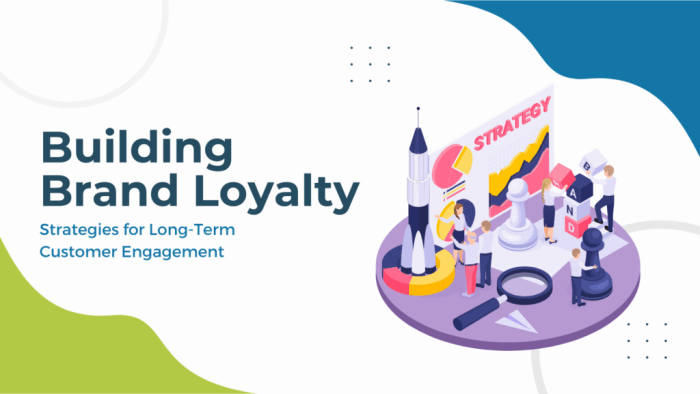Building Brand Loyalty sets the stage for businesses to thrive in a competitive market, exploring the essence of customer loyalty and brand success. Get ready to dive into the world of branding and customer relationships with a fresh perspective and modern approach.
Importance of Building Brand Loyalty
Building brand loyalty is crucial for businesses as it helps in creating a strong connection with customers, leading to repeat purchases and long-term relationships. When customers are loyal to a brand, they are more likely to choose it over competitors, even if they offer similar products or services.
Impact on Customer Retention and Profitability
- Brand loyalty increases customer retention rates, as loyal customers are more likely to continue purchasing from the same brand.
- Loyal customers also tend to spend more on each purchase, contributing to higher profitability for the business.
- By focusing on building brand loyalty, businesses can reduce marketing costs as they don’t need to constantly attract new customers to make sales.
Examples of Successful Brands
- Apple: Apple has successfully built a loyal customer base through its innovative products, quality customer service, and strong brand image.
- Nike: Nike’s focus on athletic performance, innovative designs, and strong brand presence in sports have helped them create a loyal following over the years.
- Starbucks: Starbucks has built brand loyalty by creating a unique coffee experience, personalized customer service, and a strong sense of community in their stores.
Strategies for Building Brand Loyalty

In order to enhance brand loyalty, businesses can utilize a variety of strategies that cater to the needs and preferences of their target audience. By focusing on customer service, product quality, and brand image, companies can establish a strong bond with consumers and encourage repeat purchases.
Traditional Methods vs. Modern Approaches
In the past, traditional methods such as loyalty programs and discounts were commonly used to build brand loyalty. While these tactics are still effective, modern approaches like personalized marketing and social media engagement have become increasingly popular. Companies now have the opportunity to connect with customers on a more personal level and create a unique brand experience.
Role of Customer Service
Customer service plays a crucial role in building brand loyalty as it directly impacts the overall customer experience. By providing excellent support and addressing customer concerns promptly, businesses can build trust and loyalty among their customer base. A positive interaction with customer service can leave a lasting impression and encourage customers to remain loyal to a brand.
Role of Product Quality
Product quality is another key factor in establishing brand loyalty. Customers are more likely to return to a brand if they are satisfied with the quality of the products or services offered. By consistently delivering high-quality products, businesses can build a reputation for reliability and earn the trust of their customers.
Role of Brand Image
A strong brand image is essential for building brand loyalty. Companies that have a clear and consistent brand identity are more likely to attract and retain customers. By effectively communicating their values and mission, businesses can create an emotional connection with consumers and differentiate themselves from competitors.
Engaging Customers for Brand Loyalty
To build brand loyalty, companies must effectively engage customers and create strong relationships through personalized marketing strategies.
Significance of Personalized Marketing
Personalized marketing plays a crucial role in building strong relationships with customers as it shows that the company values and understands their individual preferences and needs. By delivering tailored content, offers, and experiences, companies can create a more personalized connection with customers, leading to increased loyalty and repeat business.
Examples of Interactive Campaigns
- Starbucks Rewards Program: Starbucks offers personalized rewards and incentives based on customers’ purchase history, preferences, and behavior. This interactive campaign not only encourages repeat purchases but also fosters a sense of exclusivity and appreciation among customers.
- Sephora Beauty Insider: Sephora’s loyalty program provides personalized product recommendations, exclusive offers, and birthday gifts to members based on their beauty profile and purchase history. By offering personalized experiences, Sephora strengthens its relationship with customers and encourages brand loyalty.
- Nike Run Club App: Nike’s interactive app allows users to track their runs, set goals, and connect with a community of runners worldwide. By providing a personalized and engaging experience, Nike not only promotes its products but also builds a loyal customer base of fitness enthusiasts.
Measuring Brand Loyalty

Measuring brand loyalty is crucial for businesses to understand the strength of their customer relationships and the effectiveness of their marketing efforts. By tracking key metrics and analyzing customer feedback, companies can make informed decisions to enhance brand loyalty over time.
Key Metrics for Measuring Brand Loyalty
- Repeat Purchase Rate: This metric measures the percentage of customers who make multiple purchases from the same brand. A high repeat purchase rate indicates strong brand loyalty.
- Net Promoter Score (NPS): NPS measures customer satisfaction and loyalty by asking customers how likely they are to recommend the brand to others. A high NPS indicates satisfied and loyal customers.
- Customer Lifetime Value (CLV): CLV calculates the total value a customer brings to a business over their entire relationship. A high CLV signifies loyal customers who continue to support the brand.
Importance of Customer Feedback and Data Analysis, Building Brand Loyalty
Customer feedback is essential for evaluating brand loyalty as it provides direct insight into customer satisfaction and preferences. By collecting and analyzing feedback through surveys, reviews, and social media, businesses can identify areas for improvement and tailor their strategies to enhance loyalty.
Tracking and Improving Brand Loyalty
- Utilize Customer Relationship Management (CRM) software to track customer interactions, preferences, and purchase history.
- Implement loyalty programs to reward repeat customers and incentivize brand advocacy.
- Monitor social media engagement and sentiment to gauge customer perception and sentiment towards the brand.












